At first it may seem difficult to understand all of the different aspects of electricity. At its core, electrical voltage, current, power and resistance are essential in the general understanding of the area. Without them, it can be difficult to understand all the other more advanced knowledge and perform the functions that electrical-related professions require.
What is Electricity?
Electricity is any phenomenon that occurs from a flow of electric charge. For example, lightning and electrical currents passing through power wires. This concept, however, is complex and cannot be limited to that, as it occurs in different and diversified ways. But basically, for general understanding of the term, electricity is a form of energy resulting from the presence of electrical charge at rest or in motion, and electrically charged bodies. To better understand how electricity works, it is also important to understand concepts that are part of the energy generation process, as well as the basic quantities of electricity.
Voltage
Voltage is one of the main quantities of electricity and means the potential difference between two points. That is, the difference between the number of charges. It is this difference that generates a force, causing current to circulate, allowing electrical charges to move. Electrical voltage is also known as Differential Potential (PDD) or Electromotive Force (EMF), which as its name suggests, is the force that moves electrons. This term is symbolized by the letter U and its measurement is in Volts (V). Want an example of what it’s like in practice? If in a house the electrician said that the electrical network is 220 volts, it means that the electrical voltage is 220V. Simple as that! It is worth remembering that there are two types of voltage: direct (DC) and alternating (AC). The first, continuous, means that the polarity will not change over time. For example, cells and batteries will always have the same polarity. Meanwhile, in alternating electrical voltage, the polarity is alternated as per the frequency. Such as the socket, motors, appliances and fans. In homes, the electrical voltage is low, while in electrical installations it is high voltage.
Current
Electric current is the flow of electric charges in an electrical conductor, such as wires. All orderly motion through a conductor is a current of electricity. For a current to occur, there must be a potential difference, so it is related to electric voltage. The intensity of an electric current will depend on the number of electrons that are moving in the conductor. Therefore, the more electrons, the greater the electric current. The quantity is represented by the letter I being measured in Ampere (A). Some examples of conductors widely used in the electrical sector is metal, as they offer high and easy current conductivity.
Power
The time it takes for a piece of equipment or device to convert electrical energy into work is electrical power. That is, the time used to trigger a circuit. This time is usually measured in seconds. Consider a light bulb whose power is 50 W. This means that it takes 1 second to transform 50 joules of energy into light. The same thing happens in the case of a shower, whose electrical energy is transformed into thermal energy and the greater the power, the greater its power to heat the water. As a result, energy consumption will also be higher. Power is represented by the letter P, and its unit of measurement is Watt (W).
Resistance
Electrical resistance is the ability offered by a conductive material for an electric current to pass through in the generation of energy. In a simpler way, the difficulty that an electrical conductor has in continuing its flow through a given conductor is resistance. The lower the difficulty that the material offers, the lower the resistance. But what exactly are these difficulties? Well, there are some factors that can collaborate or hinder the passage through the conductors, such as the material itself, temperature, width, length, shape, among others. It is not always possible to guarantee that electric currents travel through the conductor 100%. So, the lower the resistance, the better this conductor is. Its symbol is R and the Ohms (Ω) unit of measurement.
Grounding
Grounding is a system that directs leakage currents to the ground, being a safety measure so that professionals do not receive electric shocks. This also allows the mains and equipment to work normally without any faults or interference. Despite being a more complex concept, it is fundamental for those who work with electricity, especially in large installations.
Units Of Measurement
Ampere
The Ampere is the unit of measurement of electric current, according to the International System of Units (SI) standard. It is represented by the symbol A. In a current, electrons move in an orderly fashion to pass through a conducting material. The number of electrons per second that form the current is measured in Ampere. Understanding this concept is fundamental to understand the need for an electric power generator, according to the amperes of an equipment or device.
Watt
The watt, whose symbol is represented by the letter W, is related to power. It means the amount of energy in joules converted per second. That is, the measurement of how much energy is being used, is measured by the watts.
Volt
Volts are the unit of measurement for electrical voltage, that is, the difference in electrical potential. Its symbol is V. This is one of the most common terms in electricity, even for those who don’t work in the field. That’s because you’ve certainly heard that an appliance is 110 or 220V, causing a lot of confusion among home appliance consumers. In the US, the most common are 110V outlets, as in Brazil. But in Europe, for example, it is 220V. If you plug a 110V appliance into a 220V outlet, the electrical voltage received is doubled, and it will certainly burn. Now, in case you insert a 220V appliance into a 110V outlet, it will not burn. However, it will work with half the power, since the current is not enough to meet the need. Therefore, before handling any equipment, machinery or device in an electrical installation, or maintenance, it is essential to check how many Volts it has.
kVA (Kilovolt Ampere)
The kVA, as it is known, is the acronym for kilovolt ampere. Its measurement is equivalent to 1000 voltamperes. Therefore, 1kVA is equal to 1000 VA. It is a more theoretical unit and is widely used in industrial electrical, for example, to plan an electrical circuit. The kVA can measure, for example, the power capacity of a distribution transformer.
Conclusion
So far, you can see that the 10 basic concepts of electricity that every electrician or student in the area needs to know. They are all interconnected, so comprehensive understanding is essential. We hope that this content has answered some questions and helped you to better understand all the concepts presented here.
Until next time!


